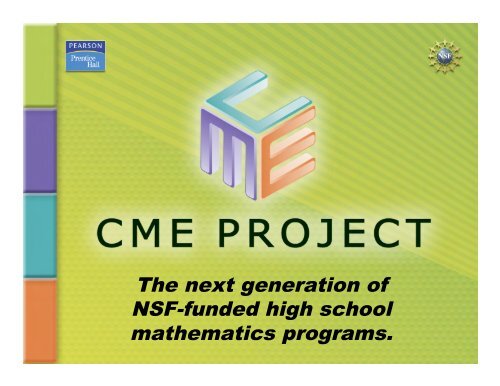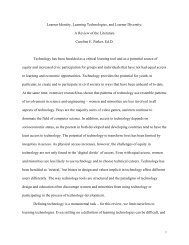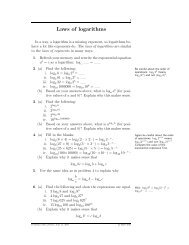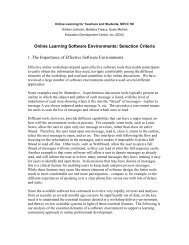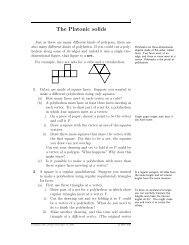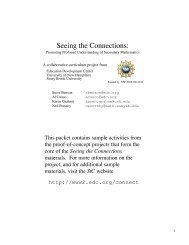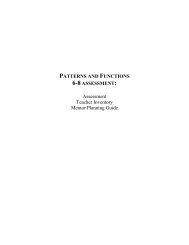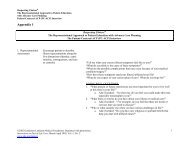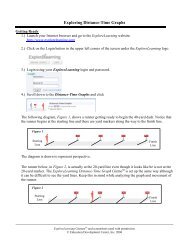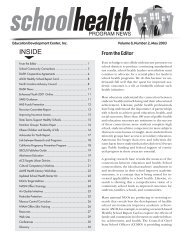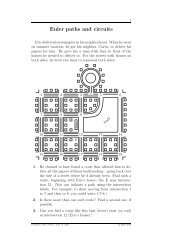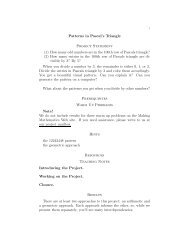Presentation Slides (pdf) - Education Development Center
Presentation Slides (pdf) - Education Development Center
Presentation Slides (pdf) - Education Development Center
You also want an ePaper? Increase the reach of your titles
YUMPU automatically turns print PDFs into web optimized ePapers that Google loves.
The next generation of<br />
NSF-funded high school<br />
mathematics programs.
CME Project<br />
Promoting Mathematical Habits of<br />
Mind in High School<br />
Session Presenters<br />
Al Cuoco, Bowen Kerins, Sarah Sword,<br />
Kevin Waterman<br />
<strong>Center</strong> for Mathematics <strong>Education</strong>, EDC<br />
acuoco@edc.org<br />
www.edc.org/cmeproject<br />
www.phschool.com/cme
Opinions about the<br />
discipline<br />
...the future well-being of our nation and people<br />
depends not just on how well we educate our<br />
children generally, but on how well we educate<br />
them in mathematics and science specifically.<br />
John Glenn, September, 2000<br />
The only people who need to study calculus are<br />
people who want to be calculus teachers.<br />
Bill Cosby, April, 1999
...and about how to learn it<br />
I’d never use a curriculum that has worked<br />
out examples in the student text.<br />
Nancy McLaughlin<br />
CME Project Teacher Advisory Board<br />
I’d never use a curriculum that doesn’t have<br />
worked-out examples in the student text.<br />
Chuck Garabedian<br />
CME Project Teacher Advisory Board
The Utility of Mathematics<br />
Mathematics constitutes one of the most ancient<br />
and noble intellectual traditions of humanity. It is<br />
an enabling discipline for all of science and<br />
technology, providing powerful tools for analytical<br />
thought as well as the concepts and language for<br />
precise quantitative description of the world around us.<br />
It affords knowledge and reasoning of<br />
extraordinary subtlety and beauty, even at the<br />
most elementary levels.<br />
RAND Mathematics Study Panel, 2002
CME Project<br />
CME Project<br />
Overview<br />
Problem-Based,<br />
Student-<strong>Center</strong>ed<br />
Approach<br />
Comprehensive<br />
4-year Curriculum
CME Project Overview<br />
Contributors<br />
EDC’s <strong>Center</strong> for Mathematics<br />
<strong>Education</strong><br />
National Advisory Board<br />
Core Mathematical Consultants<br />
Teacher Advisory Board<br />
Field-Test Teachers
CME Project Overview<br />
Fundamental Organizing Principle<br />
The widespread utility and effectiveness<br />
of mathematics come not just from<br />
mastering specific skills, topics, and<br />
techniques, but more importantly, from<br />
developing the ways of thinking—the<br />
habits of mind—used to create the<br />
results.
CME Project Overview<br />
“Traditional” course structure:<br />
it’s familiar but different<br />
Structured around the sequence of Algebra 1,<br />
Geometry, Algebra 2, Precalculus<br />
Uses a variety of instructional approaches<br />
Focuses on particular mathematical habits<br />
Uses examples and contexts from many fields<br />
Organized around mathematical themes
CME Project Overview<br />
CME Project audience:<br />
the (large number of) teachers who…<br />
Want the familiar course structure<br />
Want a problem- and exploration-based<br />
program<br />
Want to bring activities to “closure”<br />
Want rigor and accessibility for all
CME Project Overview<br />
Relationship with Texas Instruments<br />
CME Project makes<br />
essential use of<br />
technology:<br />
A “function-modeling”<br />
language (FML)<br />
A computer algebra<br />
system (CAS)<br />
An interactive geometry<br />
environment
CME Project Overview<br />
Why CAS-Based Technology?<br />
To make tractable and to enhance many beautiful<br />
classical topics, historically considered too technical<br />
for high school students.<br />
To support experiments with algebraic expressions<br />
and other mathematical objects in the same way that<br />
calculators can be used to experiment with numbers.<br />
To allow students to build computational models of<br />
algebraic objects and structures that have no faithful<br />
physical counterparts.
CME Project Approach<br />
Getting Started<br />
Example 1: Arithmetic to Algebra<br />
Instructional Approach:<br />
An Investigation is a collection of Lessons<br />
The first lesson in each investigation is<br />
Getting Started<br />
Launched with little or no instruction<br />
Previews upcoming ideas in simple<br />
contexts<br />
Provides teachers with a diagnostic tool
CME Project Approach<br />
Getting Started<br />
Example 1: Arithmetic to Algebra<br />
Extending a Rule<br />
Extending number systems<br />
Extending operations “coherently”
CME Project Approach<br />
Algebra 1<br />
The multiplication table, reoriented
CME Project Approach<br />
In-Class Experiment<br />
Example 2: More Arithmetic to Algebra<br />
Instructional Approach<br />
Launches a topic, or<br />
Provides experience before formality, or<br />
Connects ideas
CME Project Approach<br />
In-Class Experiment<br />
Example 2: More Arithmetic to Algebra<br />
Investigating Algebraic Structures<br />
A central ingredient of algebraic thinking<br />
Parallel structure between integers and<br />
polynomials
CME Project Approach<br />
Precalculus<br />
The Polynomial Factor Game<br />
x – 1 x 2 – 1 x 3 – 1 x 4 – 1 x 5 – 1<br />
x 6 – 1<br />
x 7 – 1<br />
x 8 – 1<br />
x 9 – 1<br />
x 10 – 1<br />
x 11 – 1<br />
x 12 – 1<br />
x 13 – 1<br />
x 14 – 1<br />
x 15 – 1<br />
x 16 – 1<br />
x 17 – 1<br />
x 18 – 1<br />
x 19 – 1<br />
x 20 – 1<br />
x 21 – 1<br />
x 22 – 1<br />
x 23 – 1<br />
x 24 – 1<br />
x 25 – 1<br />
x 26 – 1<br />
x 27 – 1<br />
x 28 – 1<br />
x 29 – 1<br />
x 30 – 1
CME Project Approach<br />
TI Connection
CME Project Approach<br />
Minds in Action<br />
Example 3: Geometry to Analysis<br />
Instructional Approach<br />
A mathematical conversation among students<br />
Characters reappear throughout the program<br />
Students begin to talk like the characters
CME Project Approach<br />
Minds in Action<br />
Example 3: Geometry to Analysis<br />
Reasoning by Continuity<br />
A central ingredient of analytic thinking<br />
Previews ideas of calculus
CME Project Approach<br />
Geometry<br />
You are on a camping trip, returning<br />
from a walk. Standing at Y, you<br />
notice that your tent (located at T) is<br />
on fire. You need to run to the river,<br />
fill your bucket with water, and get to the tent. Where<br />
should you land on the shore to minimize the total<br />
distance of the trip?
CME Project Approach<br />
TI Connection
CME Project Approach<br />
Minds in Action<br />
Geometry<br />
Tony<br />
Derman<br />
Tony<br />
Hey Derman, do you remember the<br />
“burning tent” problem? It said...<br />
Yes, I remember that we tried to<br />
find the best spot to fill the bucket<br />
in the river and minimize the total<br />
distance you had to run.<br />
Well, I was thinking about solving it<br />
by looking at some “wrong”<br />
answers…
CME Project Approach<br />
Minds in Action<br />
Geometry<br />
Tony<br />
…like this one.<br />
Derman<br />
Why would you do that?
CME Project Approach<br />
TI Connection
CME Project Approach<br />
Minds in Action<br />
“Students begin to talk like<br />
the characters”<br />
A real dialogue about<br />
order of operations<br />
from an Algebra 1<br />
Field Test Site
Sara<br />
Zoie<br />
Sara<br />
CME Project Approach<br />
Minds in Action<br />
Algebra 1<br />
I found your number. It’s −5.9.<br />
Wrong.<br />
It’s right! Look.<br />
Sara goes through a process of reversing<br />
steps.<br />
Sara<br />
See?
Zoie<br />
CME Project Approach<br />
Minds in Action<br />
Algebra 1<br />
Look.<br />
Zoie goes through steps on her calculator…<br />
Sara<br />
Uh-uh! You can’t do that!<br />
You have to push<br />
“equals” every time.
CME Project Approach<br />
Minds in Action<br />
Algebra 1<br />
Zoie<br />
Sara<br />
Zoie<br />
Sara<br />
No! It’s the same.<br />
Is it?<br />
Well, it should be. But it’s not.<br />
Why do you think it isn’t?<br />
Because of “please my dear<br />
stuff”...you know...order of<br />
operations!
CME Project Approach<br />
Minds in Action<br />
Algebra 1<br />
Zoie<br />
Sara<br />
Oooh. Yeah! So it’s not the same.<br />
Eew. We sound like Tony and<br />
Sasha.
CME Project Approach<br />
Projects<br />
Example 4: An Algebraic Interlude<br />
Instructional Approach: Project<br />
At the end of each chapter<br />
Two types<br />
Independent research<br />
Develop a personal understanding of a<br />
mathematical exposition
CME Project Approach<br />
Projects<br />
Example 4: An Algebraic Interlude<br />
Patterns are non-trivial<br />
Justifying the pattern<br />
Seeking Patterns
CME Project Approach<br />
Projects<br />
Algebra 2<br />
Number of Irreducible Factors of x n – 1<br />
n<br />
1<br />
2<br />
3<br />
4<br />
5<br />
6<br />
factors<br />
n<br />
7<br />
8<br />
9<br />
10<br />
11<br />
12<br />
factors
CME Project Approach<br />
TI Connection
CME Project Approach<br />
Projects<br />
Algebra 2<br />
Number of Irreducible Factors of x n – 1<br />
n<br />
1<br />
2<br />
3<br />
4<br />
5<br />
6<br />
factors<br />
1<br />
2<br />
2<br />
3<br />
2<br />
4<br />
n<br />
7<br />
8<br />
9<br />
10<br />
11<br />
12<br />
factors<br />
2<br />
4<br />
3<br />
4<br />
2<br />
6
Comprehensive Curriculum<br />
Recurring Theme<br />
Example 5: Algorithmic Thinking<br />
Program Approach: Recurring Theme<br />
Visited in each course<br />
Deepened in each grade<br />
Generalizing<br />
A central ingredient of algebraic thinking<br />
Emphasis on recursive thinking
Comprehensive Curriculum<br />
Recurring Theme<br />
Algebra 1<br />
Find a function that matches each table:
Comprehensive Curriculum<br />
Recurring Theme<br />
Algebra 2<br />
Table A: Two Models
Comprehensive Curriculum<br />
Recurring Theme<br />
Precalculus
CME Project Approach<br />
TI Connection
Comprehensive Curriculum<br />
Recurring Theme<br />
Precalculus<br />
g(255)<br />
=<br />
g(254) + 5<br />
def of g<br />
=<br />
f (254) + 5<br />
CSS<br />
=<br />
5(254) + 3 + 5<br />
def of f<br />
=<br />
5(254 + 1) + 3<br />
arithmetic<br />
=<br />
5(255) + 3<br />
more arithmetic<br />
=<br />
f (255)<br />
def of f
Comprehensive Curriculum<br />
Recurring Theme<br />
Precalculus<br />
g(n)<br />
=<br />
g(n – 1) + 5<br />
def of g<br />
=<br />
f (n – 1) + 5<br />
CSS<br />
=<br />
5(n – 1) + 3 + 5<br />
def of f<br />
=<br />
5n – 5 + 3 + 5<br />
distributive prop<br />
=<br />
5n + 3<br />
arithmetic<br />
=<br />
f (n)<br />
def of f
Comprehensive Curriculum<br />
Recurring Context<br />
Example 6: Modeling with Functions<br />
Program Approach: Recurring<br />
Context<br />
Visited in each course<br />
Deepened in each grade<br />
Building a model<br />
Refining “actions” into coherent<br />
processes<br />
Chunking
Comprehensive Curriculum<br />
Recurring Context<br />
Algebra 1
Comprehensive Curriculum<br />
Recurring Context<br />
Algebra 2<br />
Suppose you want to buy a car that costs<br />
$10,000. You have $1000 for a down-payment.<br />
The interest rate is 5%, and the loan must be<br />
paid off in 3 years. If the most you can pay per<br />
month is $350, can you afford to buy this car?<br />
This situation leads to the questions<br />
“How does a bank figure out the monthly<br />
payment on a loan?”<br />
or<br />
“How does a bank figure out the balance<br />
you owe at the end of each month?”
Comprehensive Curriculum<br />
Recurring Context<br />
Algebra 2<br />
Take 1<br />
What you owe at the end of the month is<br />
what you owed at the start of the month<br />
minus the monthly payment.<br />
b(<br />
n,<br />
m)<br />
=<br />
# 9000<br />
"<br />
! b(<br />
n $ 1, m)<br />
$<br />
m<br />
if<br />
if<br />
n<br />
n<br />
=<br />
><br />
0<br />
0
Comprehensive Curriculum<br />
Recurring Context<br />
Algebra 2<br />
Take 2<br />
b(<br />
n,<br />
m)<br />
=<br />
# 9000<br />
"<br />
! b(<br />
n $ 1, m)<br />
+<br />
.05<br />
12<br />
b(<br />
n<br />
$ 1, m)<br />
$<br />
m<br />
if<br />
if<br />
n<br />
n<br />
=<br />
><br />
0<br />
0<br />
becomes<br />
b(<br />
n,<br />
m)<br />
=<br />
# 9000<br />
"<br />
!(<br />
.05<br />
1$<br />
)<br />
12<br />
b(<br />
n<br />
$ 1, m)<br />
$<br />
m<br />
if<br />
if<br />
n<br />
n<br />
=<br />
><br />
0<br />
0<br />
Students can then use successive<br />
approximation to find m so that<br />
b(36, m) = 0
Comprehensive Curriculum<br />
Recurring Context<br />
Algebra 2<br />
Let’s try it:<br />
What’s the monthly payment on a<br />
5% interest loan of $9000 for 36<br />
months?
CME Project Approach<br />
TI Connection
Comprehensive Curriculum<br />
Recurring Context<br />
Algebra 2
Comprehensive Curriculum<br />
Recurring Context<br />
Algebra 2
Comprehensive Curriculum<br />
Recurring Context<br />
Algebra 2
Comprehensive Curriculum<br />
Recurring Context<br />
Algebra 2
Comprehensive Curriculum<br />
Recurring Context<br />
Algebra 2
CME Project Approach<br />
TI Connection
Comprehensive Curriculum<br />
Recurring Context<br />
Algebra 2/Precalculus
Comprehensive Curriculum<br />
Recurring Context<br />
Algebra 2/Precalculus
CME Project<br />
CME Project<br />
Overview<br />
Problem-Based,<br />
Student-<strong>Center</strong>ed<br />
Approach<br />
Comprehensive<br />
4-year Curriculum
CME Project Availability<br />
Dates<br />
Available right now!<br />
• CME Project Algebra 1 Sampler<br />
Available in Spring 2007<br />
• CME Project Geometry Sampler<br />
• CME Project Technology Sampler<br />
Available in Fall 2007<br />
• Piloting of Algebra 1/Geometry<br />
• CME Algebra 1 text (November 2007)<br />
• CME Geometry text (November 2007)<br />
Available in Spring 2008<br />
• CME Algebra 2 text<br />
Available in Summer 2008<br />
• CME Precalculus text


